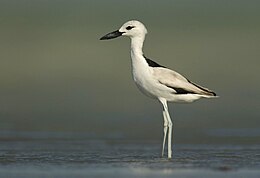Dromas ardeola
| Crab-plover | |
|---|---|
 |
|
| Scientific classification | |
| Kingdom: | Animalia |
| Phylum: | Chordata |
| Class: | Aves |
| Order: | Charadriiformes |
| Family: |
Dromadidae GR Gray, 1840 |
| Genus: |
Dromas Paykull, 1805 |
| Species: | D. ardeola |
| Binomial name | |
|
Dromas ardeola Paykull, 1805 |
|
 |
|
The crab-plover or crab plover (Dromas ardeola) is a bird related to the waders, but sufficiently distinctive to merit its own family Dromadidae. Its relationship within the Charadriiformes is unclear, some have considered it to be closely related to the thick-knees, or the pratincoles, while others have considered it closer to the auks and gulls. It is the only member of the genus Dromas and is unique among waders in making use of ground warmth to aid incubation of the eggs.
This bird resembles a plover, but has very long grey legs and a strong heavy black bill similar to a tern. Its black-and-white plumage and long-necked upright posture with heavy bill makes it distinctive and unmistakable. Its bill is unique among waders, and specialised for eating crabs. It has partially webbed toes. The plumage is white except for black on its back and in the primary feathers of the wings. They are noisy birds, calling frequently on their breeding sites and in their wintering grounds. The usual call is a ka similar to that of the bar-tailed godwit but repeated rapidly. Flocks may produce a whinnying sound that rises and at in the breeding season produce whistling kew-ki-ki notes.
Males and females are not easily distinguished but males have a heavier and longer bill. Juveniles have the black on the mantle, greyish and remain in this plumage for a year. Flocks fly in lines or "V" formations.
The crab-plover is one of the species to which the Agreement on the Conservation of African-Eurasian Migratory Waterbirds (AEWA) applies.
It is resident on the coasts and islands of the Indian Ocean, where it feeds on crabs and other small animals. They are gregarious and will feed in large groups, at night and during dawn and dusk as well as during the day; this crepuscular and nocturnal behaviour is more common during the breeding season. They breed around the Arabian Sea of Pakistan, Gulf of Oman and the Persian Gulf, Red Sea and Somalia in the months of April to July then disperse across the Indian Ocean in August as far as the Andaman Islands and Sri Lanka in the east and Tanzania and Madagascar.
...
Wikipedia

